Ch 5 Complex Phenotypes and Gene Interactions
1/41
There's no tags or description
Looks like no tags are added yet.
Name | Mastery | Learn | Test | Matching | Spaced |
|---|
No study sessions yet.
42 Terms
pseudoautosomal inheritance
refers to the very few genes found on both X and Y chromosomes
these genes behave like autosomes (non-sex chromosomes)
other genes on the X are not present on the Y, making males hemizygous (only one copy of an allele instead of 2)
hemizygous
only one copy of an allele instead of 2
ex., Y chromosome has few genes
Y chromosome
? chromosome is shrinking
full of repetitive sequences
very difficult to sequence the Y chromosome
complete sequence published in 2023 (for regerence, the 1st RD of human reference genome was published in 2000…)
little sequence variation in Y chromosome between father and son with no recombination to maternal chromosomes
recombination: pieces of DNA exchanged between homologous chromosomes->new combinations of alleles and creating genetic diversity in offspring (different than crossing over)
can trace Y chromosome directly to father, paternal grandfather, etc.
little recombination on y
little sequence variation in Y chromosome between father and son with no recombination to maternal chromosomes
recombination: pieces of DNA exchanged between homologous chromosomes->new combinations of alleles and creating genetic diversity in offspring (different than crossing over)
can trace Y chromosome directly to father, paternal grandfather, etc.
8% of men in 16 populations spanning Asia (and 0.5% of men worldwide) share nearly identical Y chromosome sequences. The variation that did exist in their DNA suggested that the lineage began around 1000 years ago in Mongolia (prob relatives of Genghis Khan)
sex linked genes
found on 1 of the 2 types of sex chromosomes, but not both
X linked
hemizygous in males
only 1 copy
males are more likely to be affected (as they only inherit 1 copy of X chromosome)
Y linked
relatively few genes in humans
referred to as holandric genes
transmitted only from father to son (female has no Y chromosome)
punnet squares of X-linked traits
punnett square show different results depending on which sex is affected
Male can transmit his one X or Y chromosome
Affected males can’t have an affected male offspring unless the female is a carrier (bc the X chromosome for sons will only ever come from mom)
patterns observed vary greatly from expected Mendelian ratios depending on whether males or females harbor the alleles
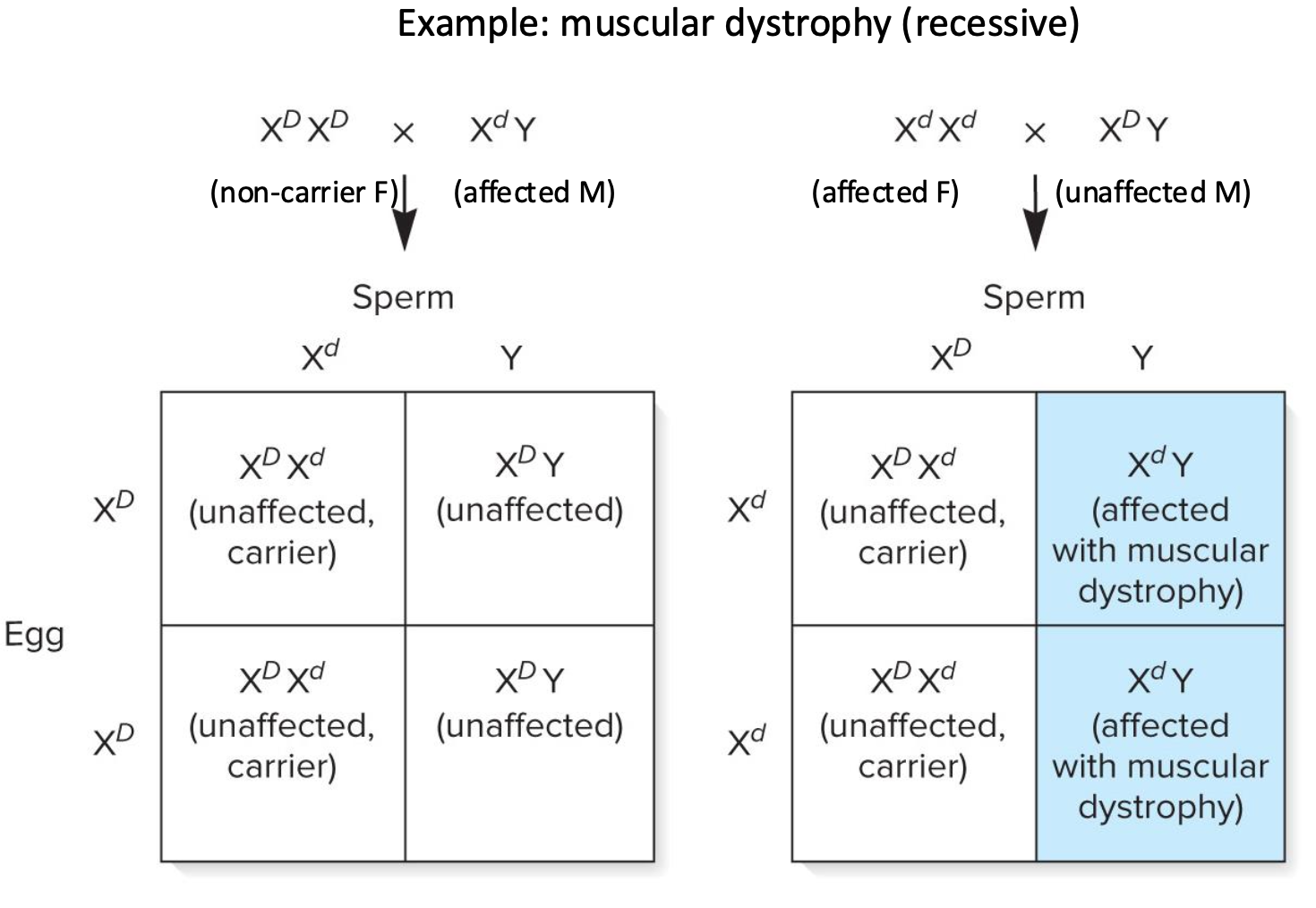
pedigree for X linked disease
pedigree for ? shows that it is mostly males that are affected with their mothers as carriers
all female carriers crossed to unaffected males
unaffected males can’t have affected female offspring
they always give dominant, wild type allele to daughters
logic (daughter gets 1 X from dad, and if he’s unaffected with a dominant, wild type allele…)
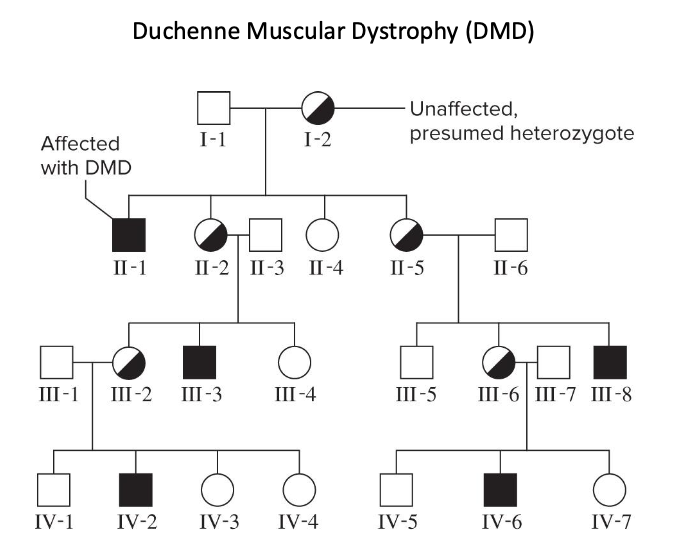
lethal alleles
have the potential to cause the death of an organism
result of mutations in essential genes (required for survival)
often recessive
only around 1/3 of all genes are thought to be essential for survival
may produce ratios that seemingly deviate from Mendelian ratios (due to the absence of homozygous carriers)
these individuals are not counted, bc THEY DON’T SURVIVE LONG ENOUGH TO BE COUNTED
ex., manx cat
dominant mutation that affects the spine and shortens the tail
this allele is lethal as a homozygote
1:2 ratio of kittens that are born
Rather than expected 3:1 (since AA is not present to be phenotyped)
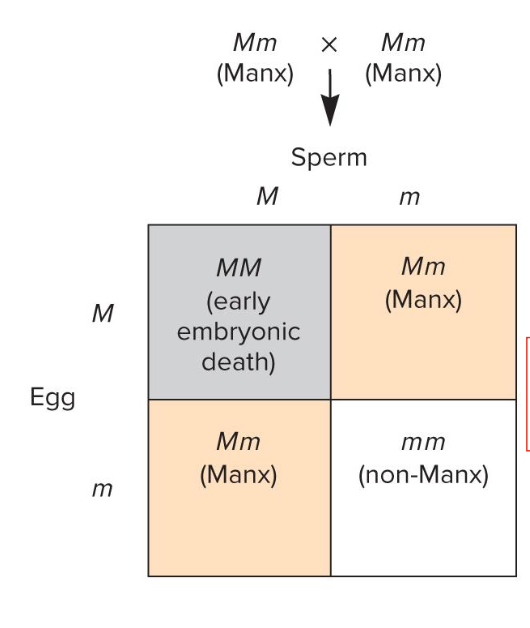
pleiotropy
single gene causes multiple phenotypes
can be caused bc
the gene product can affect cell function in more than one way
the gene may be expressed in different cell types
the gene may be expressed at different stages of development
major consideration in disease, developmental, and evolutionary biology
ex., cystic fibrosis
functional (wild-type) allele encodes the cystic fibrosis transmembrane conductance regulator (CFTR_
regulates ionic balance by transporting Cl- ions
mutant doesn’t transport Chloride effectively
in lungs, this causes very thick mucus
on the skin, causes salty sweat
poor weight gain due to blockages in tubes that carry digestive enzymes
ex., biased patterns of gene loss in icefishes
? score = number of non-blood associated phenotypes in mouse mutants
more than 1
most genes affect ? traits
pleiotropy
ex., cystic fibrosis
functional (wild-type) allele encodes the cystic fibrosis transmembrane conductance regulator (CFTR_
regulates ionic balance by transporting Cl- ions
mutant doesn’t transport Chloride effectively
in lungs, this causes very thick mucus
on the skin, causes salty sweat
poor weight gain due to blockages in tubes that carry digestive enzymes
ex., biased patterns of gene loss in icefishes
? score = number of non-blood associated phenotypes in mouse mutants
lethal allele
ex., manx cat
dominant mutation that affects the spine and shortens the tail
this allele is lethal as a homozygote
1:2 ratio of kittens that are born
Rather than expected 3:1 (since AA is not present to be phenotyped)
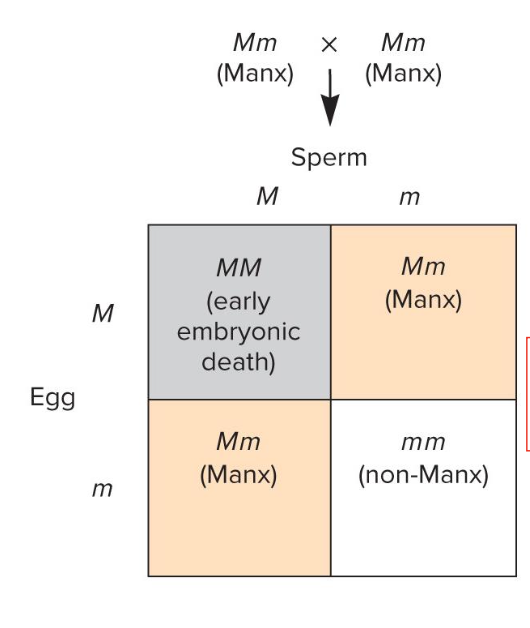
gene interactions
gene products (usually proteins) function in a soup of thousands of other gene products inside of living cells
the impact of gene mutations therefore usually depends on the broader context of what else is happening inside the cell
gene interactions occur when 2 or more different genes influence the outcome of a single trait
nearly all traits are affected to some extent by contributions of many genes
morphological traits like height, weight, and pigmentation are affected by many different genes in combination with environmental factors
ex., complementation: 2 affected parents with unaffected offspring due to having mutations in separate genes (which functionally complement each other)
ex., epistasis: one gene masks phenotype of an allele of another gene
ex., modifier: one gene “modifiers" phenotype of an allele of another gene
ex., redundancy: mutation in >=2 genes necessary for phenotype
complementation
two affected parents have unaffected offspring due to having mutations in separate genes (which functionally complement each other)
2 genes can both, independently, cause purple flowers
cross of 2 true-breeding recessive traits results in a dominant phenotype
very suggestive of ?
suggests white mutations are on different genes in each parent
the 2 genes have complementary roles, can both lead to a phenotype
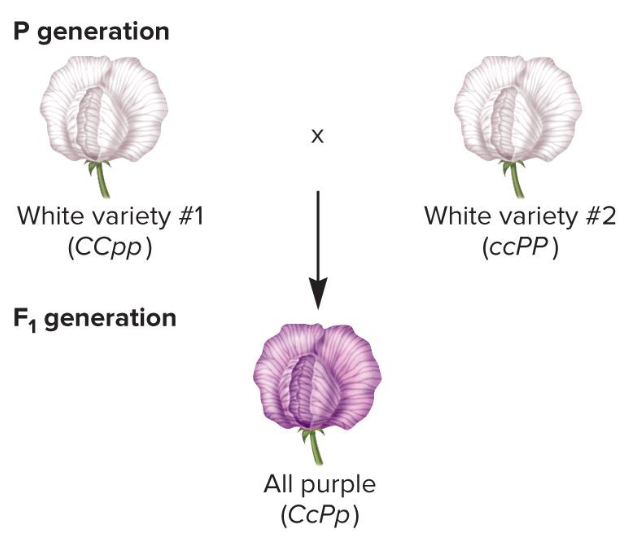
epistasis
one gene masks phenotype of an allele of another gene
modifier
one gene “modifier” phenotype of an allele of another gene
redundancy
mutation in >=2 genes necessary for phenotype
complementation test
if you have 2 strains of white flowered plants- are they caused by alleles of the same gene or alleles of different genes?
if there is complementation (e.g., 2 recessive traits crossed show the wild-type phenotype), this indicates phenotype caused by multiple genes
if there is no complementation, (trait remains true-breeding), phenotype caused by alleles of 1 gene
? refers to cases where alleles of two different genes cause the same phenotype
if the mutation is in the same gene- they won’t complement
If phenotypes are caused by different genes, each strain is likely wild-type at the other strain’s gene
this makes things behave as a 2 gene cross, leading to the appearance of the wild-type trait in the F1
epistasis
a gene masks the phenotypic effects of another gene
epistatic interactions often arise because 2 (or more) different proteins participate in a common cellular function
homozygous alleleic version of either white gene (cc or pp) both of which lead to white flowers
Both C and P genes required for purple flowers
form of ? (e.g., dominant C or P allele) masks purple (wildtype) phenotype of other gene)
ex., though Pp or PP should be purple, it’s phenotype is white because of cc
in this cross, purple/white flowers appear in 9:7 ratios in F2 generation
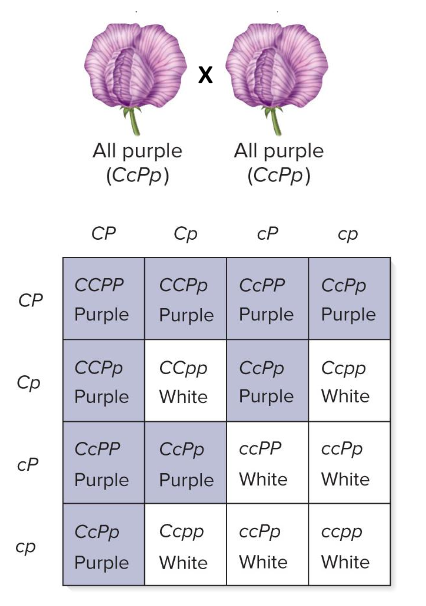
modifiers
unlike epistasis (which masks), ? ALTER the phenotype
alleles of one gene modify the phenotypic affect of another
ex., coat color in mice
black- all eumelanin
brown/agouti- bands of eumelanin/phaeomelanin
albino- no melanin
F1: true breeding black mouse x true breeding albino results in agouti color
F2: 9 agouti: 3: black 4: albino (when have confusing phenotypic ratios, use punnett squares)
assume a 2 locus (dihybrid) cross, and that we know parents were true breeding (homozygous)
each F1 is AaCc
true breeding P are: aaCC(black) or AAcc (albino)
trick is to find a coherent combo of genotypes that match the phenotypes
result:
Aa/AA- brown (mix of black and yellow)
aa: black throughout entire hair
cc no pigmentation
one copy of each dominant allele results in agouti color
one dominant C but recessive aa will be black
the four cc animals are albino, even if the dominant A is present
c is epistatic to A
(aa can also be considered epistatic to C where aa modifies agouti to black)
caused by 2 genes
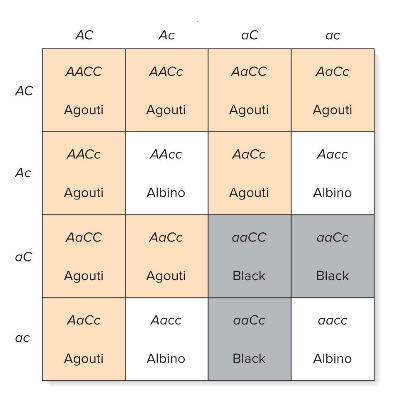
gene redundancy
one gene compensates for the function of another
common with loss of function alleles (mutations that eliminate the activity of gene products)
here, another gene product accomplishes the task missing from the loss of function mutation
can create loss of function in the lab- gene knockout
random mutagenesis, CRISPR/Cas9 genome editing
gene duplication results in the creation of one or more copies of a gene that become more divergent over time
duplicated genes are paralogs
one gene copy can compensate for loss of function in another
other proteins carry out similar functions, enough to compensate for losses
(altered) phenotype only when both redundant genes are lost
ex., seed capsule shape
P: triangular x ovate
F1: all triangular
F2: 15 triangular:1 ovate
only recessive for both genes (ttvv) is ovate
T and V have redundant function (takes loss of both to see phenotype)
paralogs
duplicated genes
pleiotropy
gene does >1 thing
epistasis
gene masks mutant allele of another gene
complementation
phenotype due to mutations in separate genes
modifier
gene changes the phenotype of another gene’s allele
redundancy
need mutations in greater than or equal to 2 genes for a trait
complementation test
if you have 2 strains of white flowered plants- are they caused by alleles of the same gene or alleles of different genes?
if there is ? (e.g., 2 recessive traits crossed show the wild-type phenotype), this indicates phenotype caused by multiple genes
if there is no ?, (trait remains true-breeding), phenotype caused by alleles of 1 gene
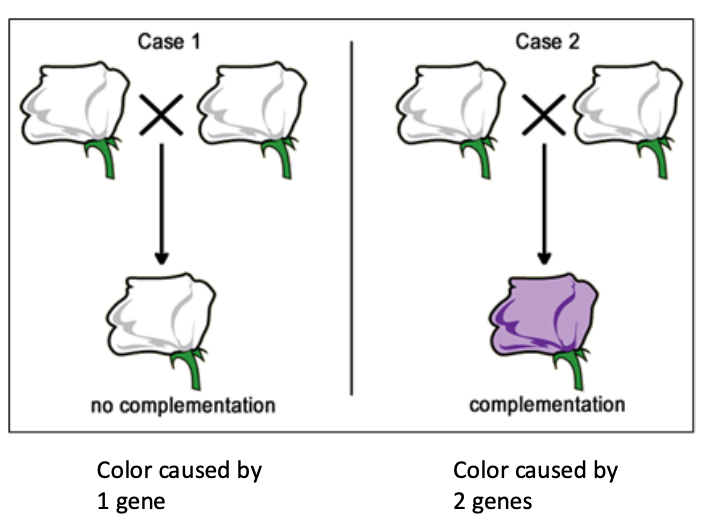
complementation test
If phenotypes are caused by different genes, each strain is likely wild-type at the other strain’s gene
this makes things behave as a 2 gene cross, leading to the appearance of the wild-type trait in the F1
so for this cross:
wildtype B allele from strain 1 rescues the recessive b allele from strain 2
wildtype A allele from strain 2 rescues the dominant a from strain 1
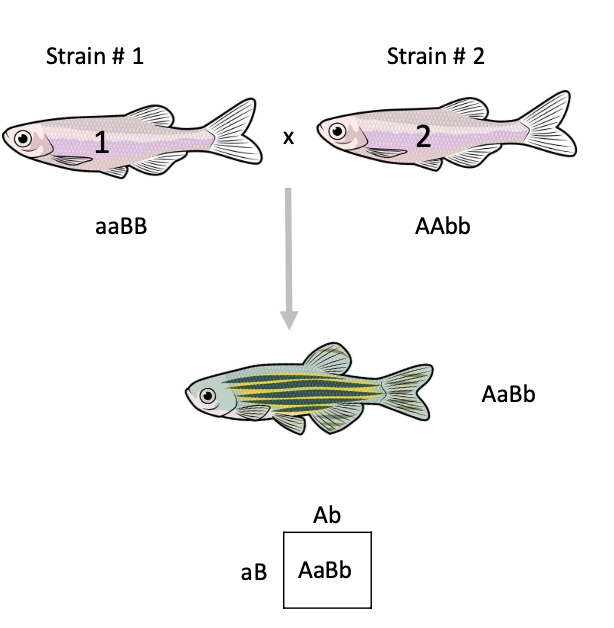
complementation table
failure to complement (-) means the strains have mutations in the same gene
complementation (+) means we have different genes
strains will always fail to complement themselves (-)
the best way to solve these is to go one row or column at a time, and gradually build up complementation groups each time you encounter failure of complementation (-)
In this table, we find that 1=3=6, 2=4, 5=7. So we have isolated variants in 3 different genes from our screen as causing the albino trait
In other words: 1,3 and 6 are alleles of the same gene, 2 and 4 are likely alleles of the same gene, but 2/4 is a different gene than 1/3/6

complementation
same phenotype caused by mutations in different genes
3
Here are the results of a complementation test. How many genes are mutated across these 7 strains?
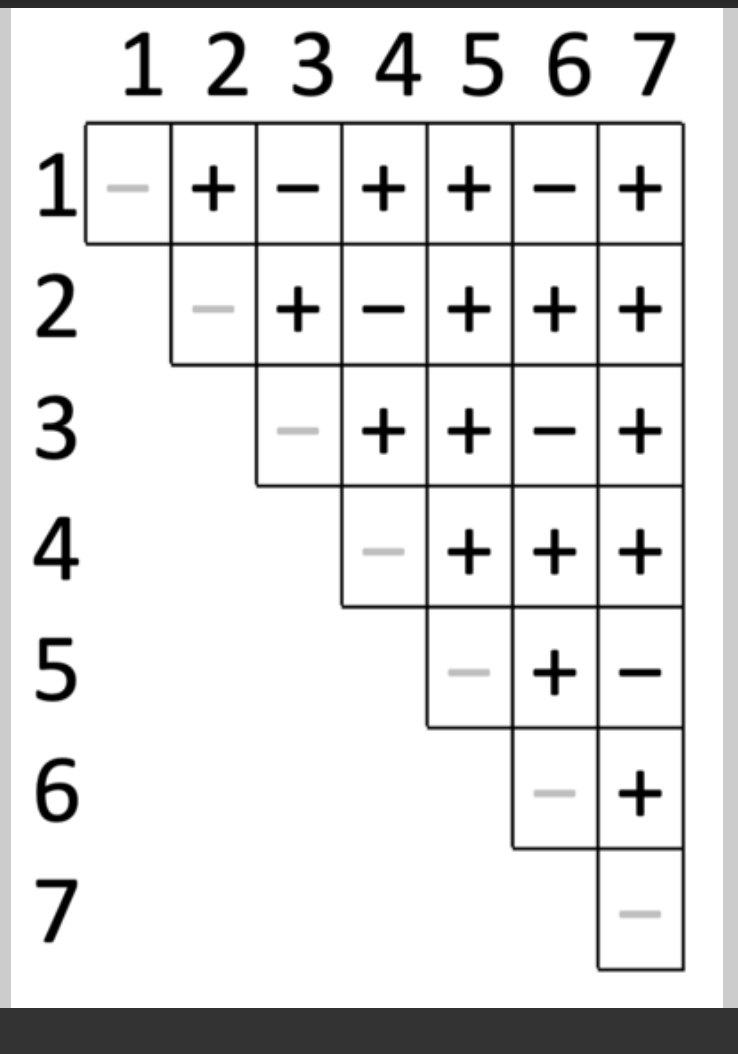
redundancy
A 15:1 F2 phenotypic ratio of a dihybrid cross is typical of
complementation
A phenomenon where two affected, recessive parents have unaffected offspring?
Allele is lethal in homozygotes
You expect a 3:1 ratio of phenotypes from a F2 monohybrid cross. Instead you observe 2:1. What might be happening?
pleiotropy
A mutation in a single gene impacts flower color and plant height. This is an example of:
modifiers
You cross two brown mice together and get a 9:3:4 phenotypic ratio of brown:black:white mice. What is happening?
epistasis
Deep in the heart of a top secret McDonald's research facility, you breed two purple Grimaces together and a get 9:7 ratio of purple to white Grimaces. What could explain this outcome?
1, hemizygous
Human males have ___ copies of the X chromosome, making genes on this chromosome ___